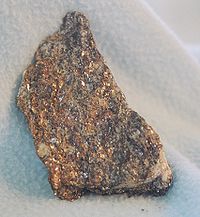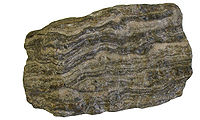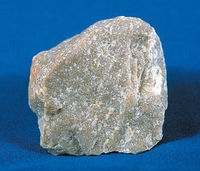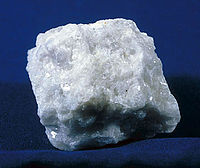4.3: Metamorphic Rocks
- Page ID
- 12683
In this lesson you will learn about metamorphic rocks, how they form, and some of their common uses. Figure 4.13 shows a large outcrop of metamorphic rocks. Notice the platy layers that run from left to right within the rock. It looks as though you could easily break off layers from the front surface of the outcrop. This layering is a result of the process of metamorphism. Metamorphism is the changing of rocks by heat and pressure. During this process, rocks change either physically and/or chemically. They change so much that they become an entirely new rock.

Figure 4.13: The platy layers in this large outcrop of metamorphic rock show the effects of pressure on rocks during metamorphism.
Lesson Objectives
- Describe how metamorphic rocks are formed.
- Describe the properties of some common metamorphic rocks.
- Relate some common uses of metamorphic rocks.
Metamorphism
Metamorphic rocks start off as igneous, sedimentary, or other metamorphic rocks. These rocks are changed when heat or pressure alters the existing rock’s physical or chemical make up. One ways rocks may change during metamorphism is by rearrangement of their mineral crystals. When heat and pressure change the environment of a rock, the crystals may respond by rearranging their structure. They will form new minerals that are more stable in the new environment. Extreme pressure may also lead to the formation of foliation, or flat layers in rocks that form as the rocks are squeezed by pressure. Foliation normally forms when pressure was exerted on a rock from one direction. If pressure is exerted from all directions, then the rock usually does not show foliation.
There are two main types of metamorphism:
- Contact metamorphism—occurs when magma contacts a rock, changing it by extreme heat (Figure 4.14).
- Regional metamorphism—occurs when great masses of rock change over a wide area due to pressure exerted on rocks at plate boundaries.

Figure 4.14: This diagram shows hot magma within the earth contacting various rock layers. This is an example of contact metamorphism.
It is important to note that metamorphism does not cause complete melting of the initial rock. It only causes changes to a rock by heat or pressure. The rearrangement of the mineral crystals is the most common way that we notice these changes. Table 4.3 shows some common metamorphic rocks and the original rocks that they come from.

Figure 4.15: Marble is used for decorative items and in art.
Hornfels, with its alternating bands of dark and light crystals is a good example of how minerals rearrange themselves during metamorphism. In this case, the minerals separated by density and became banded. Gneiss forms by regional metamorphism from both high temperature and pressure.
Quartzite and marble are the most commonly used metamorphic rocks. They are frequently chosen for building materials and artwork. Marble is used for statues and decorative items like vases (Figure 4.15). Ground up marble is also a component of toothpaste, plastics, and paper. Quartzite is very hard and is often crushed and used in building railroad tracks (Figure 4.16). Schist and slate are sometimes used as building and landscape materials.

Figure 4.16: Crushed quartzite is sometimes placed under railroad tracks because it is very hard and durable.
Lesson Summary
- Metamorphic rocks form when heat and pressure transform an existing rock into a new rock.
- Contact metamorphism occurs when hot magma transforms rock that it contacts.
- Regional metamorphism transforms large areas of existing rocks under the tremendous heat and pressure created by tectonic forces.
Review Questions
- Why do the minerals in a rock sometimes rearrange themselves when exposed to heat or pressure?
- What is foliation in metamorphic rocks?
- Describe the different conditions that lead to foliated versus non-foliated metamorphic rocks.
- List and describe the two main types of metamorphism.
- How can metamorphic rocks be a clue to how they were formed?
- Suppose a phyllite sample was metamorphosed again. How might it look different after this second round of metamorphism.
Vocabulary
- contact metamorphism
- Results from temperature increases when a body of magma contacts a cooler existing rock.
- foliation
- Property of some metamorphic rocks in which flat layers are formed; seen as evidence of squeezing by pressure.
- regional metamorphism
- Occurs when great masses of rock change over a wide area due to pressure.
- stable
- Steady and not likely to change significantly any more.
Points to Consider
- What type of plate boundary would produce the most intense metamorphism of rock?
- Do you think new minerals could form when an existing rock is metamorphosed?
- Earth Science for High School. Provided by: CK-12. Located at: http://www.ck12.org/book/CK-12-Earth-Science-For-High-School/?noindex=None. License: CC BY-NC: Attribution-NonCommercial







